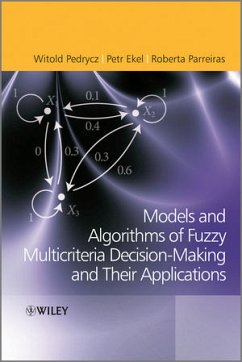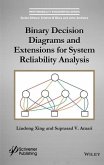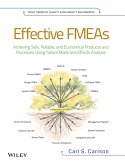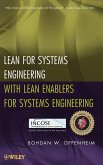Witold Pedrycz, Petr Ekel, Roberta Parreiras
Fuzzy Multicriteria Decision-Making
Models, Methods and Applications
Witold Pedrycz, Petr Ekel, Roberta Parreiras
Fuzzy Multicriteria Decision-Making
Models, Methods and Applications
- Gebundenes Buch
- Merkliste
- Auf die Merkliste
- Bewerten Bewerten
- Teilen
- Produkt teilen
- Produkterinnerung
- Produkterinnerung
Fuzzy Multicriteria Decision-Making: Models, Algorithms and Applications addresses theoretical and practical gaps in considering uncertainty and multicriteria factors encountered in the design, planning, and control of complex systems. Including all prerequisite knowledge and augmenting some parts with a step-by-step explanation of more advanced concepts, the authors provide a systematic and comprehensive presentation of the concepts, design methodology, and detailed algorithms. These are supported by many numeric illustrations and a number of application scenarios to motivate the reader and…mehr
Andere Kunden interessierten sich auch für
![Binary Decision Diagrams and Extensions for System Reliability Analysis Binary Decision Diagrams and Extensions for System Reliability Analysis]() Liudong XingBinary Decision Diagrams and Extensions for System Reliability Analysis194,99 €
Liudong XingBinary Decision Diagrams and Extensions for System Reliability Analysis194,99 €![Effective Fmeas Effective Fmeas]() Carl CarlsonEffective Fmeas146,99 €
Carl CarlsonEffective Fmeas146,99 €![Electrical Energy Efficiency Electrical Energy Efficiency]() Andreas M. SumperElectrical Energy Efficiency124,99 €
Andreas M. SumperElectrical Energy Efficiency124,99 €![Lean Systems Lean Systems]() Bohdan W. OppenheimLean Systems122,99 €
Bohdan W. OppenheimLean Systems122,99 €![Product Maturity 1 Product Maturity 1]() Franck BayleProduct Maturity 1177,99 €
Franck BayleProduct Maturity 1177,99 €![Introduction to Fuzzy Logic Introduction to Fuzzy Logic]() James K. PeckolIntroduction to Fuzzy Logic135,99 €
James K. PeckolIntroduction to Fuzzy Logic135,99 €![Foundations of Fuzzy Control Foundations of Fuzzy Control]() Jan JantzenFoundations of Fuzzy Control124,99 €
Jan JantzenFoundations of Fuzzy Control124,99 €-
-
-
Fuzzy Multicriteria Decision-Making: Models, Algorithms and Applications addresses theoretical and practical gaps in considering uncertainty and multicriteria factors encountered in the design, planning, and control of complex systems. Including all prerequisite knowledge and augmenting some parts with a step-by-step explanation of more advanced concepts, the authors provide a systematic and comprehensive presentation of the concepts, design methodology, and detailed algorithms. These are supported by many numeric illustrations and a number of application scenarios to motivate the reader and make some abstract concepts more tangible. Fuzzy Multicriteria Decision-Making: Models, Algorithms and Applications will appeal to a wide audience of researchers and practitioners in disciplines where decision-making is paramount, including various branches of engineering, operations research, economics and management; it will also be of interest to graduate students and senior undergraduate students in courses such as decision making, management, risk management, operations research, numerical methods, and knowledge-based systems. * Offers a new, unified, comprehensive and application-oriented perspective to the state of the art of uncertainty in decision-making. * Supported by a significant amount of illustrative numeric material, application scenarios, exercises and problems. * accompanying wesite www.wiley.com/go/pedrycz houses PPT slides and auxiliary exercises/problems as well as worked-through examples.
Hinweis: Dieser Artikel kann nur an eine deutsche Lieferadresse ausgeliefert werden.
Hinweis: Dieser Artikel kann nur an eine deutsche Lieferadresse ausgeliefert werden.
Produktdetails
- Produktdetails
- Verlag: John Wiley & Sons / Wiley
- Seitenzahl: 360
- Erscheinungstermin: 1. Dezember 2010
- Englisch
- Abmessung: 252mm x 177mm x 25mm
- Gewicht: 750g
- ISBN-13: 9780470682258
- ISBN-10: 0470682256
- Artikelnr.: 30588758
- Herstellerkennzeichnung
- Libri GmbH
- Europaallee 1
- 36244 Bad Hersfeld
- gpsr@libri.de
- Verlag: John Wiley & Sons / Wiley
- Seitenzahl: 360
- Erscheinungstermin: 1. Dezember 2010
- Englisch
- Abmessung: 252mm x 177mm x 25mm
- Gewicht: 750g
- ISBN-13: 9780470682258
- ISBN-10: 0470682256
- Artikelnr.: 30588758
- Herstellerkennzeichnung
- Libri GmbH
- Europaallee 1
- 36244 Bad Hersfeld
- gpsr@libri.de
Witold Pedrycz, Electrical & Computer Engineering, University of Alberta, Canada Witold Pedrycz is a Professor and Canada Research Chair (CRC) in the Department of Electrical and Computer Engineering, University of Alberta, Edmonton, Canada. He is also with the Systems Research Institute of the Polish Academy of Sciences. His research covers computational intelligence, fuzzy modeling, knowledge discovery and data mining, fuzzy control including fuzzy controllers, pattern recognition, knowledge-based neural networks, relational computation, bioinformatics, and software engineering. He has published numerous papers in this area, and is also the author of 11 research monographs covering various aspects of computational intelligence and software engineering. He currently serves as Editor-in-Chief of IEEE Trans. on Systems, Man and Cybernetics, Part A and Information Sciences. He is also an Associate Editor of IEEE Transactions on Fuzzy Systems. Petr Ekel is a Professor in the Graduate Program in Electrical Engineering, Pontifical Catholic University of Minas Gerais, Belo Horizonte, Brazil. His research activities in the field of system modeling, optimization, and control include discrete and fuzzy programming, fuzzy multicriteria decision-making, fuzzy preference modeling, fuzzy identification and control. More than 40 projects with industry, including projects based on applying techniques of decision-making in a fuzzy environment and fuzzy identification and control, have been realized under his leadership or with his participation. Petr Ekel has been a member of numerous program committees of conferences related to system modeling, optimization, and control, including conferences in the areas of computational intelligence and fuzzy sets. He is a member of the editorial boards of several international journals. Roberta Parreiras received a PhD in electrical engineering from the Federal University of Minas Gerais, Belo Horizonte, Brazil, in 2006. In 2008, she concluded her post-doctoral activities in the Pontifical Catholic University of Minas Gerais, Belo Horizonte, Brazil, where she is currently as an assistant professor in the Electrical Engineering Department. Her research has been reported in papers and book chapters in the areas of multicriteria fuzzy decision-making, group decision-making, consensus schemes, multiobjective optimization, evolutionary search algorithms and robust optimization.
About the Authors.
Foreword.
Preface.
1 Decision-Making in System Project, Planning, Operation, and Control:
Motivation, Objectives, and Basic Concepts.
1.1 Decision-Making and its Support.
1.2 Optimization and Decision-Making Problems.
1.3 Multicriteria Decision-Making.
1.4 Group Decision-Making.
1.5 Fuzzy Sets and their Role in Decision-Making Processes.
1.6 Conclusions.
References.
2 Notions and Concepts of Fuzzy Sets: An Introduction.
2.1 Sets and Fuzzy Sets: A Fundamental Departure from the Principle of
Dichotomy.
2.2 Interpretation of Fuzzy Sets.
2.3 Membership Functions and Classes of Fuzzy Sets.
2.4 Fuzzy Numbers and Intervals.
2.5 Linguistic Variables.
2.6 A Generic Characterization of Fuzzy Sets: Some Fundamental Descriptors.
2.7 Geometric Interpretation of Sets and Fuzzy Sets.
2.8 Fuzzy Sets and the Family of ¿-cuts.
2.9 Operations on Fuzzy Sets.
2.11 Conclusions.
References.
3 Selected Design and Processing Aspects of Fuzzy Sets.
3.1 The Development of Fuzzy Sets: Elicitation of Membership Functions.
3.2 Aggregation Operations.
3.3 Transformations of Fuzzy Sets.
3.4 Conclusions.
References.
4 Continuous Models ofMulticriteria Decision-Making and their Analysis.
4.1 Continuous Models (X,M Models) of Multicriteria Decision-Making.
4.2 Pareto-Optimal Solutions.
4.3 Approaches to the Use of DM Information.
4.4 Methods of Multiobjective Decision-Making.
4.5 Bellman?Zadeh Approach and its Application to Multicriteria
Decision-Making.
4.6 Multicriteria Resource Allocation.
4.7 Adaptive Interactive Decision-Making System for Multicriteria Resource
Allocation.
4.8 Application of the Bellman?Zadeh Approach to Multicriteria Problems.
4.9 Conclusions.
References.
5 Introduction to Preference Modeling with Binary Fuzzy Relations.
5.1 Binary Fuzzy Relations and their Fundamental Properties.
5.2 Preference Modeling with Binary Fuzzy Relations.
5.3 Preference Structure of Binary Fuzzy Preference Relations.
5.4 A Method for Constructing a Fuzzy Preference Structure.
5.5 Consistency of Fuzzy Preference Relations.
5.6 Conclusions.
References.
6 Construction of Fuzzy Preference Relations.
6.1 Preference Formats.
6.2 Ordering of Fuzzy Quantities and the Construction of Fuzzy Preference
Relations.
6.3 Transformation Functions and their Use for Converting Different
Preference Formats into Fuzzy Preference Relations.
6.4 A Method for Repairing Inconsistent Judgments.
6.5 Conclusions.
References.
7 Discrete Models of Multicriteria Decision-Making and their Analysis.
7.1 Optimization Problems with Fuzzy Coefficients and their Analysis.
7.2 Discrete Models (X, R Models) of Multiattribute Decision-Making.
7.3 Basic Techniques of Analysis of X, R Models.
7.4 Interactive Decision-Making System for Multicriteria Analysis of
Alternatives in a Fuzzy Environment.
7.5 Multicriteria Analysis of Alternatives with Fuzzy Ordering of Criteria.
7.6 Multicriteria Analysis of Alternatives with the Concept of Fuzzy
Majority.
7.7 Multicriteria Analysis of Alternatives Based on an Outranking Approach
(Fuzzy Promethee).
7.8 Application Examples.
7.9 Conclusions.
References.
8 Generalization of a Classic Approach to Dealing with Uncertainty of
Information for Multicriteria Decision Problems.
8.1 Classic Approach to Dealing with Uncertainty of Information.
8.2 Choice Criteria.
8.3 Generalization of the Classic Approach.
8.4 Modification of the Choice Criteria.
8.5 General Scheme of Multicriteria Decision-Making under Uncertainty.
8.6 Application Example.
8.7 Conclusions.
References.
9 Group Decision-Making: Fuzzy Models.
9.1 Group Decision-Making Problem and its Characteristics.
9.2 Strategies for the Analysis of Group Decision-Making Problems:
Multiperson and Multiattribute Aggregation Modes.
9.3 The Different Levels of Influence of Each Expert in the Construction of
the Collective Opinion.
9.4 Aggregation Operators for Constructing Collective Opinions on the Basis
of Fuzzy Models and their Properties.
9.5 Consistency of Pairwise Judgments in Group Decision-Making.
9.6 Fuzzy Group Decision-Making Methods.
9.7 Conclusions.
References.
10 Use of Consensus Schemes in Group Decision-Making.
10.1 Consensus in Group Decision-Making.
10.2 Consensus Schemes: Definition and Motivation.
10.3 Fuzzy Concordance and Fuzzy Consensus Measures.
10.4 Moderator Interventions.
10.5 Optimal Consensus in a Fuzzy Environment.
10.6 Consensus Schemes in Fuzzy Environment.
10.7 An Application Related to the Balanced Scorecard Methodology.
10.8 Conclusions.
References.
Index.
Foreword.
Preface.
1 Decision-Making in System Project, Planning, Operation, and Control:
Motivation, Objectives, and Basic Concepts.
1.1 Decision-Making and its Support.
1.2 Optimization and Decision-Making Problems.
1.3 Multicriteria Decision-Making.
1.4 Group Decision-Making.
1.5 Fuzzy Sets and their Role in Decision-Making Processes.
1.6 Conclusions.
References.
2 Notions and Concepts of Fuzzy Sets: An Introduction.
2.1 Sets and Fuzzy Sets: A Fundamental Departure from the Principle of
Dichotomy.
2.2 Interpretation of Fuzzy Sets.
2.3 Membership Functions and Classes of Fuzzy Sets.
2.4 Fuzzy Numbers and Intervals.
2.5 Linguistic Variables.
2.6 A Generic Characterization of Fuzzy Sets: Some Fundamental Descriptors.
2.7 Geometric Interpretation of Sets and Fuzzy Sets.
2.8 Fuzzy Sets and the Family of ¿-cuts.
2.9 Operations on Fuzzy Sets.
2.11 Conclusions.
References.
3 Selected Design and Processing Aspects of Fuzzy Sets.
3.1 The Development of Fuzzy Sets: Elicitation of Membership Functions.
3.2 Aggregation Operations.
3.3 Transformations of Fuzzy Sets.
3.4 Conclusions.
References.
4 Continuous Models ofMulticriteria Decision-Making and their Analysis.
4.1 Continuous Models (X,M Models) of Multicriteria Decision-Making.
4.2 Pareto-Optimal Solutions.
4.3 Approaches to the Use of DM Information.
4.4 Methods of Multiobjective Decision-Making.
4.5 Bellman?Zadeh Approach and its Application to Multicriteria
Decision-Making.
4.6 Multicriteria Resource Allocation.
4.7 Adaptive Interactive Decision-Making System for Multicriteria Resource
Allocation.
4.8 Application of the Bellman?Zadeh Approach to Multicriteria Problems.
4.9 Conclusions.
References.
5 Introduction to Preference Modeling with Binary Fuzzy Relations.
5.1 Binary Fuzzy Relations and their Fundamental Properties.
5.2 Preference Modeling with Binary Fuzzy Relations.
5.3 Preference Structure of Binary Fuzzy Preference Relations.
5.4 A Method for Constructing a Fuzzy Preference Structure.
5.5 Consistency of Fuzzy Preference Relations.
5.6 Conclusions.
References.
6 Construction of Fuzzy Preference Relations.
6.1 Preference Formats.
6.2 Ordering of Fuzzy Quantities and the Construction of Fuzzy Preference
Relations.
6.3 Transformation Functions and their Use for Converting Different
Preference Formats into Fuzzy Preference Relations.
6.4 A Method for Repairing Inconsistent Judgments.
6.5 Conclusions.
References.
7 Discrete Models of Multicriteria Decision-Making and their Analysis.
7.1 Optimization Problems with Fuzzy Coefficients and their Analysis.
7.2 Discrete Models (X, R Models) of Multiattribute Decision-Making.
7.3 Basic Techniques of Analysis of X, R Models.
7.4 Interactive Decision-Making System for Multicriteria Analysis of
Alternatives in a Fuzzy Environment.
7.5 Multicriteria Analysis of Alternatives with Fuzzy Ordering of Criteria.
7.6 Multicriteria Analysis of Alternatives with the Concept of Fuzzy
Majority.
7.7 Multicriteria Analysis of Alternatives Based on an Outranking Approach
(Fuzzy Promethee).
7.8 Application Examples.
7.9 Conclusions.
References.
8 Generalization of a Classic Approach to Dealing with Uncertainty of
Information for Multicriteria Decision Problems.
8.1 Classic Approach to Dealing with Uncertainty of Information.
8.2 Choice Criteria.
8.3 Generalization of the Classic Approach.
8.4 Modification of the Choice Criteria.
8.5 General Scheme of Multicriteria Decision-Making under Uncertainty.
8.6 Application Example.
8.7 Conclusions.
References.
9 Group Decision-Making: Fuzzy Models.
9.1 Group Decision-Making Problem and its Characteristics.
9.2 Strategies for the Analysis of Group Decision-Making Problems:
Multiperson and Multiattribute Aggregation Modes.
9.3 The Different Levels of Influence of Each Expert in the Construction of
the Collective Opinion.
9.4 Aggregation Operators for Constructing Collective Opinions on the Basis
of Fuzzy Models and their Properties.
9.5 Consistency of Pairwise Judgments in Group Decision-Making.
9.6 Fuzzy Group Decision-Making Methods.
9.7 Conclusions.
References.
10 Use of Consensus Schemes in Group Decision-Making.
10.1 Consensus in Group Decision-Making.
10.2 Consensus Schemes: Definition and Motivation.
10.3 Fuzzy Concordance and Fuzzy Consensus Measures.
10.4 Moderator Interventions.
10.5 Optimal Consensus in a Fuzzy Environment.
10.6 Consensus Schemes in Fuzzy Environment.
10.7 An Application Related to the Balanced Scorecard Methodology.
10.8 Conclusions.
References.
Index.
About the Authors.
Foreword.
Preface.
1 Decision-Making in System Project, Planning, Operation, and Control:
Motivation, Objectives, and Basic Concepts.
1.1 Decision-Making and its Support.
1.2 Optimization and Decision-Making Problems.
1.3 Multicriteria Decision-Making.
1.4 Group Decision-Making.
1.5 Fuzzy Sets and their Role in Decision-Making Processes.
1.6 Conclusions.
References.
2 Notions and Concepts of Fuzzy Sets: An Introduction.
2.1 Sets and Fuzzy Sets: A Fundamental Departure from the Principle of
Dichotomy.
2.2 Interpretation of Fuzzy Sets.
2.3 Membership Functions and Classes of Fuzzy Sets.
2.4 Fuzzy Numbers and Intervals.
2.5 Linguistic Variables.
2.6 A Generic Characterization of Fuzzy Sets: Some Fundamental Descriptors.
2.7 Geometric Interpretation of Sets and Fuzzy Sets.
2.8 Fuzzy Sets and the Family of ¿-cuts.
2.9 Operations on Fuzzy Sets.
2.11 Conclusions.
References.
3 Selected Design and Processing Aspects of Fuzzy Sets.
3.1 The Development of Fuzzy Sets: Elicitation of Membership Functions.
3.2 Aggregation Operations.
3.3 Transformations of Fuzzy Sets.
3.4 Conclusions.
References.
4 Continuous Models ofMulticriteria Decision-Making and their Analysis.
4.1 Continuous Models (X,M Models) of Multicriteria Decision-Making.
4.2 Pareto-Optimal Solutions.
4.3 Approaches to the Use of DM Information.
4.4 Methods of Multiobjective Decision-Making.
4.5 Bellman?Zadeh Approach and its Application to Multicriteria
Decision-Making.
4.6 Multicriteria Resource Allocation.
4.7 Adaptive Interactive Decision-Making System for Multicriteria Resource
Allocation.
4.8 Application of the Bellman?Zadeh Approach to Multicriteria Problems.
4.9 Conclusions.
References.
5 Introduction to Preference Modeling with Binary Fuzzy Relations.
5.1 Binary Fuzzy Relations and their Fundamental Properties.
5.2 Preference Modeling with Binary Fuzzy Relations.
5.3 Preference Structure of Binary Fuzzy Preference Relations.
5.4 A Method for Constructing a Fuzzy Preference Structure.
5.5 Consistency of Fuzzy Preference Relations.
5.6 Conclusions.
References.
6 Construction of Fuzzy Preference Relations.
6.1 Preference Formats.
6.2 Ordering of Fuzzy Quantities and the Construction of Fuzzy Preference
Relations.
6.3 Transformation Functions and their Use for Converting Different
Preference Formats into Fuzzy Preference Relations.
6.4 A Method for Repairing Inconsistent Judgments.
6.5 Conclusions.
References.
7 Discrete Models of Multicriteria Decision-Making and their Analysis.
7.1 Optimization Problems with Fuzzy Coefficients and their Analysis.
7.2 Discrete Models (X, R Models) of Multiattribute Decision-Making.
7.3 Basic Techniques of Analysis of X, R Models.
7.4 Interactive Decision-Making System for Multicriteria Analysis of
Alternatives in a Fuzzy Environment.
7.5 Multicriteria Analysis of Alternatives with Fuzzy Ordering of Criteria.
7.6 Multicriteria Analysis of Alternatives with the Concept of Fuzzy
Majority.
7.7 Multicriteria Analysis of Alternatives Based on an Outranking Approach
(Fuzzy Promethee).
7.8 Application Examples.
7.9 Conclusions.
References.
8 Generalization of a Classic Approach to Dealing with Uncertainty of
Information for Multicriteria Decision Problems.
8.1 Classic Approach to Dealing with Uncertainty of Information.
8.2 Choice Criteria.
8.3 Generalization of the Classic Approach.
8.4 Modification of the Choice Criteria.
8.5 General Scheme of Multicriteria Decision-Making under Uncertainty.
8.6 Application Example.
8.7 Conclusions.
References.
9 Group Decision-Making: Fuzzy Models.
9.1 Group Decision-Making Problem and its Characteristics.
9.2 Strategies for the Analysis of Group Decision-Making Problems:
Multiperson and Multiattribute Aggregation Modes.
9.3 The Different Levels of Influence of Each Expert in the Construction of
the Collective Opinion.
9.4 Aggregation Operators for Constructing Collective Opinions on the Basis
of Fuzzy Models and their Properties.
9.5 Consistency of Pairwise Judgments in Group Decision-Making.
9.6 Fuzzy Group Decision-Making Methods.
9.7 Conclusions.
References.
10 Use of Consensus Schemes in Group Decision-Making.
10.1 Consensus in Group Decision-Making.
10.2 Consensus Schemes: Definition and Motivation.
10.3 Fuzzy Concordance and Fuzzy Consensus Measures.
10.4 Moderator Interventions.
10.5 Optimal Consensus in a Fuzzy Environment.
10.6 Consensus Schemes in Fuzzy Environment.
10.7 An Application Related to the Balanced Scorecard Methodology.
10.8 Conclusions.
References.
Index.
Foreword.
Preface.
1 Decision-Making in System Project, Planning, Operation, and Control:
Motivation, Objectives, and Basic Concepts.
1.1 Decision-Making and its Support.
1.2 Optimization and Decision-Making Problems.
1.3 Multicriteria Decision-Making.
1.4 Group Decision-Making.
1.5 Fuzzy Sets and their Role in Decision-Making Processes.
1.6 Conclusions.
References.
2 Notions and Concepts of Fuzzy Sets: An Introduction.
2.1 Sets and Fuzzy Sets: A Fundamental Departure from the Principle of
Dichotomy.
2.2 Interpretation of Fuzzy Sets.
2.3 Membership Functions and Classes of Fuzzy Sets.
2.4 Fuzzy Numbers and Intervals.
2.5 Linguistic Variables.
2.6 A Generic Characterization of Fuzzy Sets: Some Fundamental Descriptors.
2.7 Geometric Interpretation of Sets and Fuzzy Sets.
2.8 Fuzzy Sets and the Family of ¿-cuts.
2.9 Operations on Fuzzy Sets.
2.11 Conclusions.
References.
3 Selected Design and Processing Aspects of Fuzzy Sets.
3.1 The Development of Fuzzy Sets: Elicitation of Membership Functions.
3.2 Aggregation Operations.
3.3 Transformations of Fuzzy Sets.
3.4 Conclusions.
References.
4 Continuous Models ofMulticriteria Decision-Making and their Analysis.
4.1 Continuous Models (X,M Models) of Multicriteria Decision-Making.
4.2 Pareto-Optimal Solutions.
4.3 Approaches to the Use of DM Information.
4.4 Methods of Multiobjective Decision-Making.
4.5 Bellman?Zadeh Approach and its Application to Multicriteria
Decision-Making.
4.6 Multicriteria Resource Allocation.
4.7 Adaptive Interactive Decision-Making System for Multicriteria Resource
Allocation.
4.8 Application of the Bellman?Zadeh Approach to Multicriteria Problems.
4.9 Conclusions.
References.
5 Introduction to Preference Modeling with Binary Fuzzy Relations.
5.1 Binary Fuzzy Relations and their Fundamental Properties.
5.2 Preference Modeling with Binary Fuzzy Relations.
5.3 Preference Structure of Binary Fuzzy Preference Relations.
5.4 A Method for Constructing a Fuzzy Preference Structure.
5.5 Consistency of Fuzzy Preference Relations.
5.6 Conclusions.
References.
6 Construction of Fuzzy Preference Relations.
6.1 Preference Formats.
6.2 Ordering of Fuzzy Quantities and the Construction of Fuzzy Preference
Relations.
6.3 Transformation Functions and their Use for Converting Different
Preference Formats into Fuzzy Preference Relations.
6.4 A Method for Repairing Inconsistent Judgments.
6.5 Conclusions.
References.
7 Discrete Models of Multicriteria Decision-Making and their Analysis.
7.1 Optimization Problems with Fuzzy Coefficients and their Analysis.
7.2 Discrete Models (X, R Models) of Multiattribute Decision-Making.
7.3 Basic Techniques of Analysis of X, R Models.
7.4 Interactive Decision-Making System for Multicriteria Analysis of
Alternatives in a Fuzzy Environment.
7.5 Multicriteria Analysis of Alternatives with Fuzzy Ordering of Criteria.
7.6 Multicriteria Analysis of Alternatives with the Concept of Fuzzy
Majority.
7.7 Multicriteria Analysis of Alternatives Based on an Outranking Approach
(Fuzzy Promethee).
7.8 Application Examples.
7.9 Conclusions.
References.
8 Generalization of a Classic Approach to Dealing with Uncertainty of
Information for Multicriteria Decision Problems.
8.1 Classic Approach to Dealing with Uncertainty of Information.
8.2 Choice Criteria.
8.3 Generalization of the Classic Approach.
8.4 Modification of the Choice Criteria.
8.5 General Scheme of Multicriteria Decision-Making under Uncertainty.
8.6 Application Example.
8.7 Conclusions.
References.
9 Group Decision-Making: Fuzzy Models.
9.1 Group Decision-Making Problem and its Characteristics.
9.2 Strategies for the Analysis of Group Decision-Making Problems:
Multiperson and Multiattribute Aggregation Modes.
9.3 The Different Levels of Influence of Each Expert in the Construction of
the Collective Opinion.
9.4 Aggregation Operators for Constructing Collective Opinions on the Basis
of Fuzzy Models and their Properties.
9.5 Consistency of Pairwise Judgments in Group Decision-Making.
9.6 Fuzzy Group Decision-Making Methods.
9.7 Conclusions.
References.
10 Use of Consensus Schemes in Group Decision-Making.
10.1 Consensus in Group Decision-Making.
10.2 Consensus Schemes: Definition and Motivation.
10.3 Fuzzy Concordance and Fuzzy Consensus Measures.
10.4 Moderator Interventions.
10.5 Optimal Consensus in a Fuzzy Environment.
10.6 Consensus Schemes in Fuzzy Environment.
10.7 An Application Related to the Balanced Scorecard Methodology.
10.8 Conclusions.
References.
Index.








